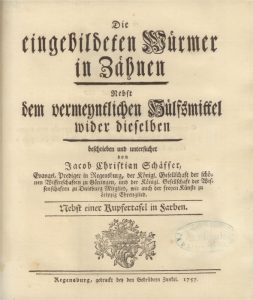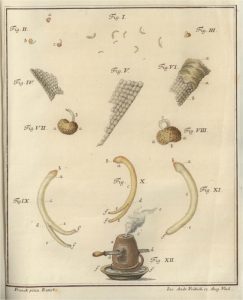The Becker Library recently acquired a very interesting work: Jacob Christian Schäffer’s Die Eingebildeten Würmer in Zähnen (The Imaginary Tooth Worms), published by the Zunkel brothers in Regensburg in 1757. This slim volume was a refutation of the long-held belief that dental cavities are caused by tooth worms – tiny worms that burrow into the teeth and cause severe torment.
Zunkel brothers in Regensburg in 1757. This slim volume was a refutation of the long-held belief that dental cavities are caused by tooth worms – tiny worms that burrow into the teeth and cause severe torment.
The tooth worm has a long history. A Mesopotamian tablet from c.1800 BCE excavated in Nippur describes treatments for teeth affected by worms, and tooth worms are also mentioned in Egyptian papyri.[1] In the first century CE, Scribonius Largus, who was the personal physician to the Emperor Claudius, wrote that, “Suitable also against toothache are fumigations made with the seeds of the hysocyamus [henbane] scattered on burning charcoal; these must be followed by rinsings of the mouth with hot water; in this way sometimes, as it were, small worms are expelled.”[2] This form of treatment gained traction during the medieval period, and a number of medical authors, including such famous figures as Avicenna and Guy de Chauliac, mention fumigation as a means of treating worms in the teeth.[3]
The tooth worm theory began to be challenged during the early modern period. In 1543, the French physician Jacques Houllier offered an initial argument against the existence of worms, and pointed out that the worm-like objects that appear after henbane seeds are burned can be seen regardless of whether or not the smoke has actually touched the afflicted tooth.[4] Some two hundred years later, the 18th century French practitioner Pierre Fauchard stated that, having never seen the worms himself, he could neither confirm nor deny their existence – but still felt that their existence was highly improbable, and they were certainly not the cause of caries.[5] But despite these expressions of skepticism, belief in the tooth worm remained strong.
Schäffer’s publication is credited with driving the proverbial nail into the tooth worm’s coffin. He did this through a series of experiments. He first fumigated his mouth without using the customary basin of water that was used to catch and drown the expelled worms, and saw nothing. When he repeated the procedure with the basin, he found plenty of "worms" in the water – however, because he did not have a toothache, he knew they couldn’t have come from his teeth.[6] The so-called worms were in fact nothing more than the seedlings of the winter cherry that became distorted after they were subjected to heat.[7]
 While Die Eingebildeten Würmer in Zähnen is a fairly modest publication at only 42 pages long, it does have a rather striking hand colored copperplate illustration. This depicts the seeds beginning to sprout after in response to heat, demonstrating how they could easily be mistaken for worms. At the very bottom is the mechanism used for the fumigation remedy: an earthen pot with a heated bar of iron thrust through it, upon which the seeds are placed, and the bowl of water that the extracted worms fall into.
While Die Eingebildeten Würmer in Zähnen is a fairly modest publication at only 42 pages long, it does have a rather striking hand colored copperplate illustration. This depicts the seeds beginning to sprout after in response to heat, demonstrating how they could easily be mistaken for worms. At the very bottom is the mechanism used for the fumigation remedy: an earthen pot with a heated bar of iron thrust through it, upon which the seeds are placed, and the bowl of water that the extracted worms fall into.
We are very happy that this work on such an interesting aspect of dental history will now make its home in the McKellops Collection!
[1] Walter Hoffmann-Axthelm. History of Dentistry. Translated by H.M. Koehler. Chicago: Quintessence Publishing Co., 1981. Page 30-31.
[2] Vincenzo Guerini, A History of Dentistry from the Most Ancient Times Until the End of the Eighteenth Century. Philadelphia and New York: Lea & Febiger, 1909. 103-104.
[3] Guerini: 125, 148.
[4] Hoffman-Axthelm: 145.
[5] Guerini: 268-269.
[6] Jacob Christian Schäffer. Die Eingebildeten Würmer in Zähnen. Regensburg: gedruckt bei den Gebrüdern Zunkel, 1757. 23-24.
[7] Hoffman-Axthelm: 243.
